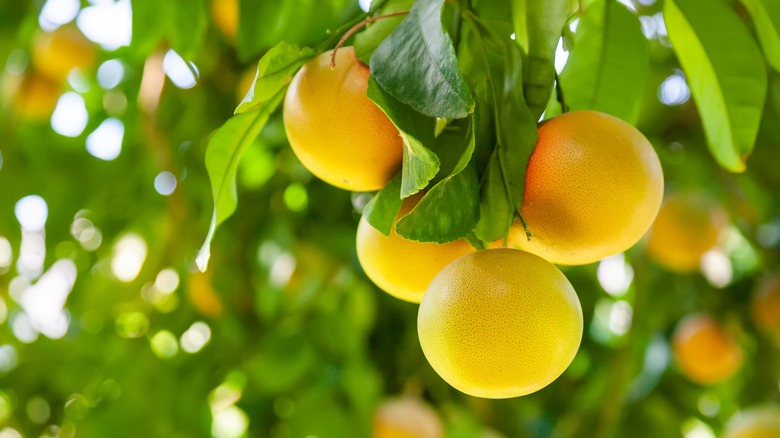Grapefruit Was Once Called The 'Forbidden Fruit'
Few foods are more polarizing than the grapefruit, drawing affection and ire that reach extremes only rivaled by cilantro and pineapple on pizza. Even grapefruit's name is contentious, as many have wondered how two such disparate fruits could share a similar title. Well, believe it or not, grapefruit most likely got its name because people thought the fruit resembled a bunch of grapes ... seriously.
According to MentalFloss, the first known use of the term 'grapefruit' came in an 1814 book by the botanist John Lunan, who wrote that it resembled a grape in flavor. If you've sampled both grapes and grapefruit, you know this isn't true, a sentiment shared by many scholars. Some historians theorize that Lunan heard the term grapefruit elsewhere and incorrectly assumed its origins and that the name actually refers to the way grapefruits grow in tight clusters that, according to the Library of Congress, resemble large bunches of grapes. But before Lunan's description, grapefruit had another name, coined by naturalist Griffith Hughes (via Purdue University Horticulture). The first European to record a description of the corpulent citrus, Hughes bestowed upon it the sinister name 'forbidden fruit.' But why?
A violent origin
A relatively modern fruit, grapefruit originated in Barbados, after Europeans invaded the island. The Spaniards were the first to arrive, doing so in a violent fashion. They launched a series of raids on the small island kidnapping and enslaving many of the native Arawak and Carib peoples (via Britannica). Those who escaped capture are assumed to have fled to other islands in the region, and eventually, Europeans left Barbados as well, leaving the island essentially abandoned for much of the 16th century.
But violence was not the only thing the Spanish brought to Barbados, the Wisconsin Department of Public Instruction explains they also brought oranges. As it turned out, those oranges have a close cousin called the pomelo. Also not native to the country (MasterClass reports the fruit was brought to Barbados in the 16th century) the pomelo is the largest citrus variety in the world, reaching up to a foot in diameter, and has a tart, bitter flavor not unlike that of ... you guessed it, grapefruit. Once both were in Barbados, orange and pomelo plants ended up growing side by side, and because citrus varieties hybridize with one another very easily, per Atlas Obscura, these plants exchanged genes, creating a brand new fruit we now recognize as grapefruit.
Two possibilities for its cautionary name
While Barbados sat virtually uninhabited grapefruit trees got busy growing, and they were prevalent on the island by the time the English arrived and Hughes coined the citrus 'forbidden fruit.' The name has uncertain origins, but two explanations have been offered. One suggests that the Europeans were so taken aback by the lush tropical climate, some wondered if they may have ventured into Eden (via World Wide Words).
But another theory on the 'forbidden' classification has been floated around, as shared by Florida's Ocala StarBanner (which is coincidentally the state that produces the most grapefruits in the U.S.). The outlet posits the name 'forbidden fruit' may have been a way for people to warn each other of the fruit's unpleasant flavor.
Grapefruit arrived in the U.S. in the early 19th century by way of Florida, per NPR, where people embraced the bitter fruit. It became a popular addition to baked goods and salads, as well as eaten plain, with a little sugar or salt to neutralize the bitterness. With its myriad health benefits, the grapefruit's 'forbidden' status has been justly eliminated.


